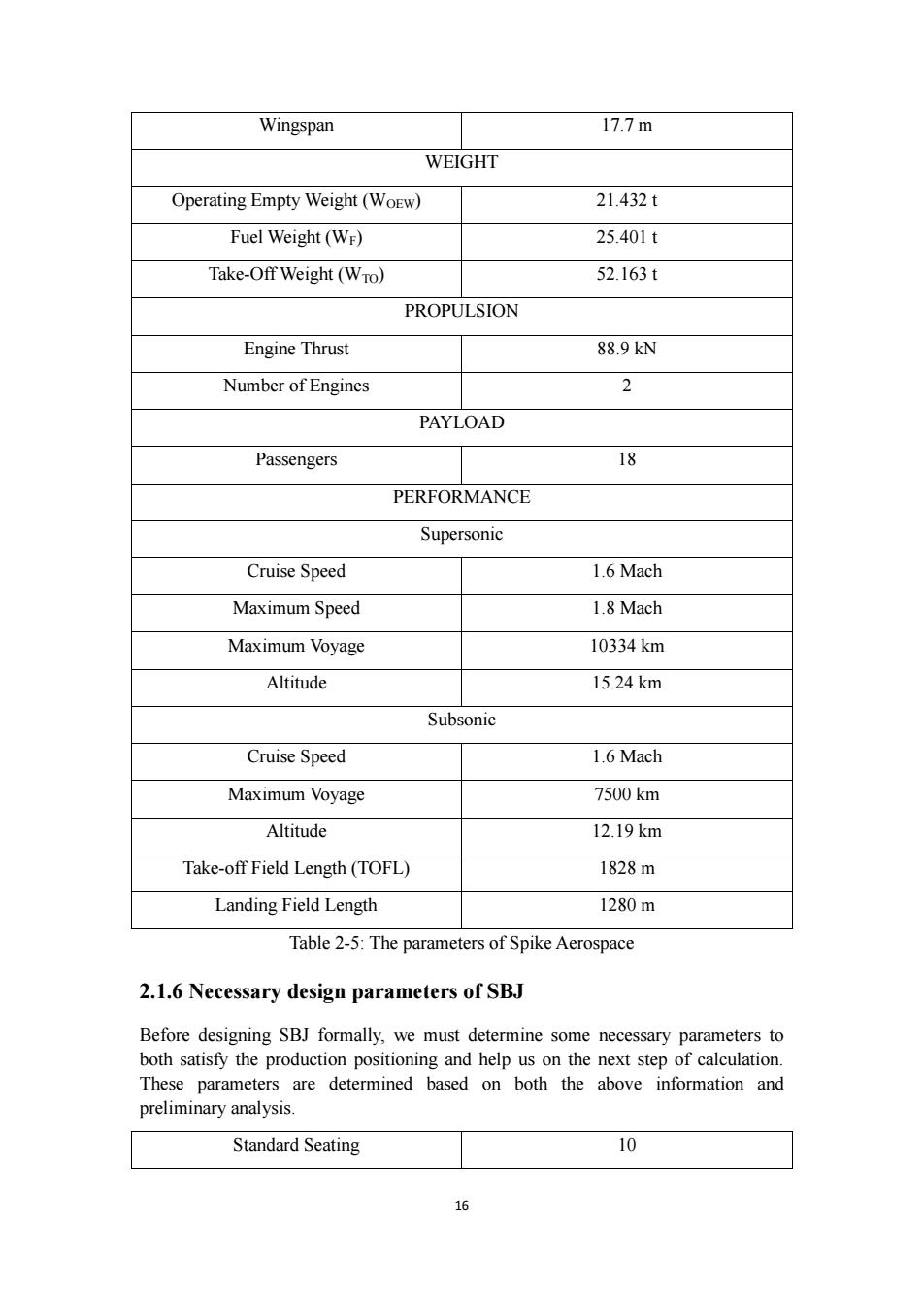
Wingspan 17.7m WEIGHT Operating Empty Weight(WoEw) 21.432t Fuel Weight(WE) 25.401t Take-Off Weight(WTo) 52.163t PROPULSION Engine Thrust 88.9kN Number of Engines 2 PAYLOAD Passengers 18 PERFORMANCE Supersonic Cruise Speed 1.6 Mach Maximum Speed 1.8 Mach Maximum Voyage 10334km Altitude 15.24km Subsonic Cruise Speed 1.6 Mach Maximum Voyage 7500km Altitude 12.19km Take-off Field Length(TOFL) 1828m Landing Field Length 1280m Table 2-5:The parameters of Spike Aerospace 2.1.6 Necessary design parameters of SBJ Before designing SBJ formally,we must determine some necessary parameters to both satisfy the production positioning and help us on the next step of calculation. These parameters are determined based on both the above information and preliminary analysis. Standard Seating 10 16
16 Wingspan 17.7 m WEIGHT Operating Empty Weight (WOEW) 21.432 t Fuel Weight (WF) 25.401 t Take-Off Weight (WTO) 52.163 t PROPULSION Engine Thrust 88.9 kN Number of Engines 2 PAYLOAD Passengers 18 PERFORMANCE Supersonic Cruise Speed 1.6 Mach Maximum Speed 1.8 Mach Maximum Voyage 10334 km Altitude 15.24 km Subsonic Cruise Speed 1.6 Mach Maximum Voyage 7500 km Altitude 12.19 km Take-off Field Length (TOFL) 1828 m Landing Field Length 1280 m Table 2-5: The parameters of Spike Aerospace 2.1.6 Necessary design parameters of SBJ Before designing SBJ formally, we must determine some necessary parameters to both satisfy the production positioning and help us on the next step of calculation. These parameters are determined based on both the above information and preliminary analysis. Standard Seating 10
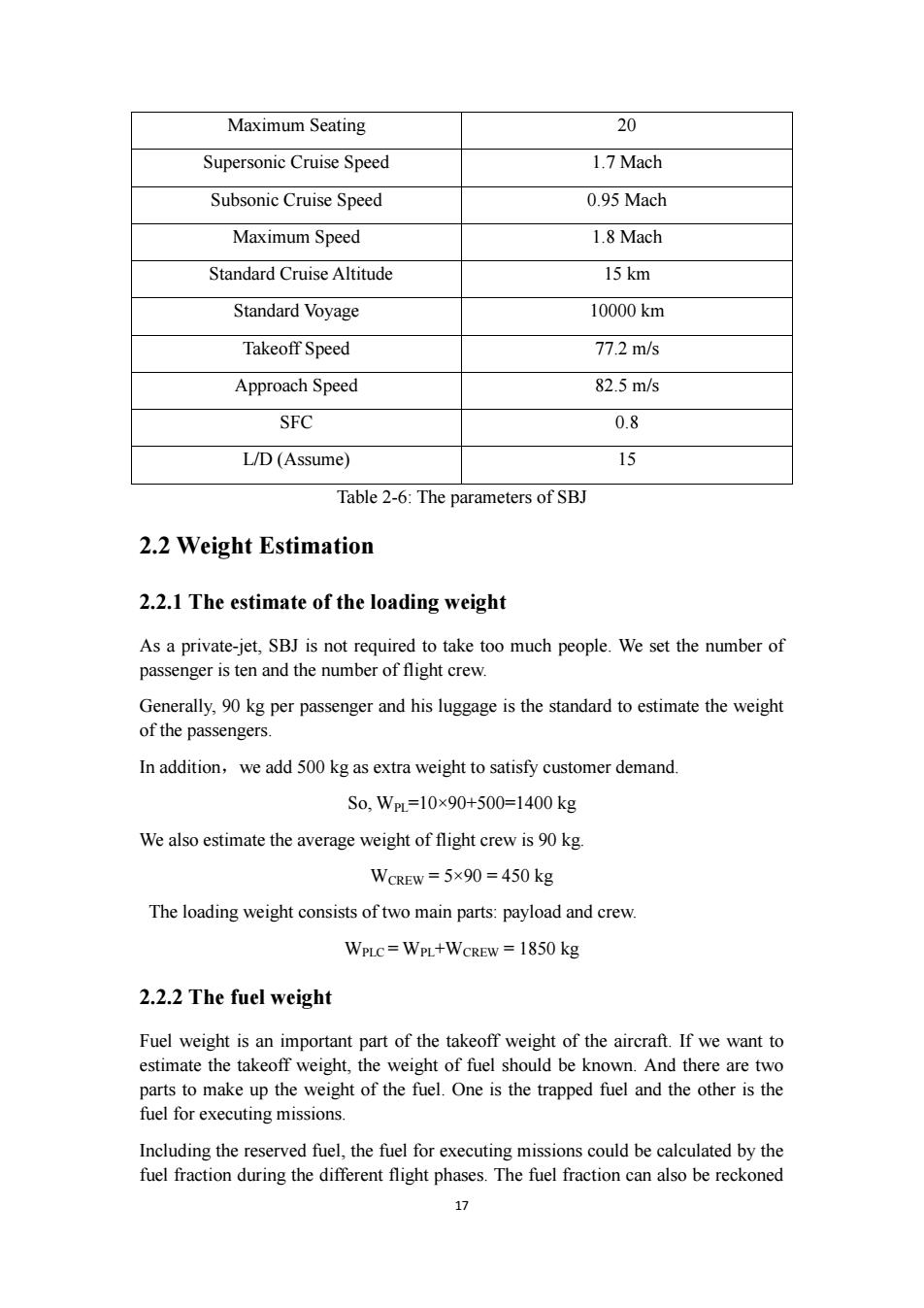
Maximum Seating 20 Supersonic Cruise Speed 1.7Mach Subsonic Cruise Speed 0.95 Mach Maximum Speed 1.8 Mach Standard Cruise Altitude 15 km Standard Voyage 10000km Takeoff Speed 77.2m/s Approach Speed 82.5m/s SFC 0.8 L/D (Assume) 15 Table 2-6:The parameters of SBJ 2.2 Weight Estimation 2.2.1 The estimate of the loading weight As a private-jet,SBJ is not required to take too much people.We set the number of passenger is ten and the number of flight crew. Generally,90 kg per passenger and his luggage is the standard to estimate the weight of the passengers. In addition,we add 500 kg as extra weight to satisfy customer demand. So,W=10×90+500=1400kg We also estimate the average weight of flight crew is 90 kg. WCREW=5×90=450kg The loading weight consists of two main parts:payload and crew. WPLC=WPL+WCREW =1850 kg 2.2.2 The fuel weight Fuel weight is an important part of the takeoff weight of the aircraft.If we want to estimate the takeoff weight,the weight of fuel should be known.And there are two parts to make up the weight of the fuel.One is the trapped fuel and the other is the fuel for executing missions. Including the reserved fuel,the fuel for executing missions could be calculated by the fuel fraction during the different flight phases.The fuel fraction can also be reckoned 17
17 Maximum Seating 20 Supersonic Cruise Speed 1.7 Mach Subsonic Cruise Speed 0.95 Mach Maximum Speed 1.8 Mach Standard Cruise Altitude 15 km Standard Voyage 10000 km Takeoff Speed 77.2 m/s Approach Speed 82.5 m/s SFC 0.8 L/D (Assume) 15 Table 2-6: The parameters of SBJ 2.2 Weight Estimation 2.2.1 The estimate of the loading weight As a private-jet, SBJ is not required to take too much people. We set the number of passenger is ten and the number of flight crew. Generally, 90 kg per passenger and his luggage is the standard to estimate the weight of the passengers. In addition,we add 500 kg as extra weight to satisfy customer demand. So, WPL=10×90+500=1400 kg We also estimate the average weight of flight crew is 90 kg. WCREW = 5×90 = 450 kg The loading weight consists of two main parts: payload and crew. WPLC = WPL+WCREW = 1850 kg 2.2.2 The fuel weight Fuel weight is an important part of the takeoff weight of the aircraft. If we want to estimate the takeoff weight, the weight of fuel should be known. And there are two parts to make up the weight of the fuel. One is the trapped fuel and the other is the fuel for executing missions. Including the reserved fuel, the fuel for executing missions could be calculated by the fuel fraction during the different flight phases. The fuel fraction can also be reckoned
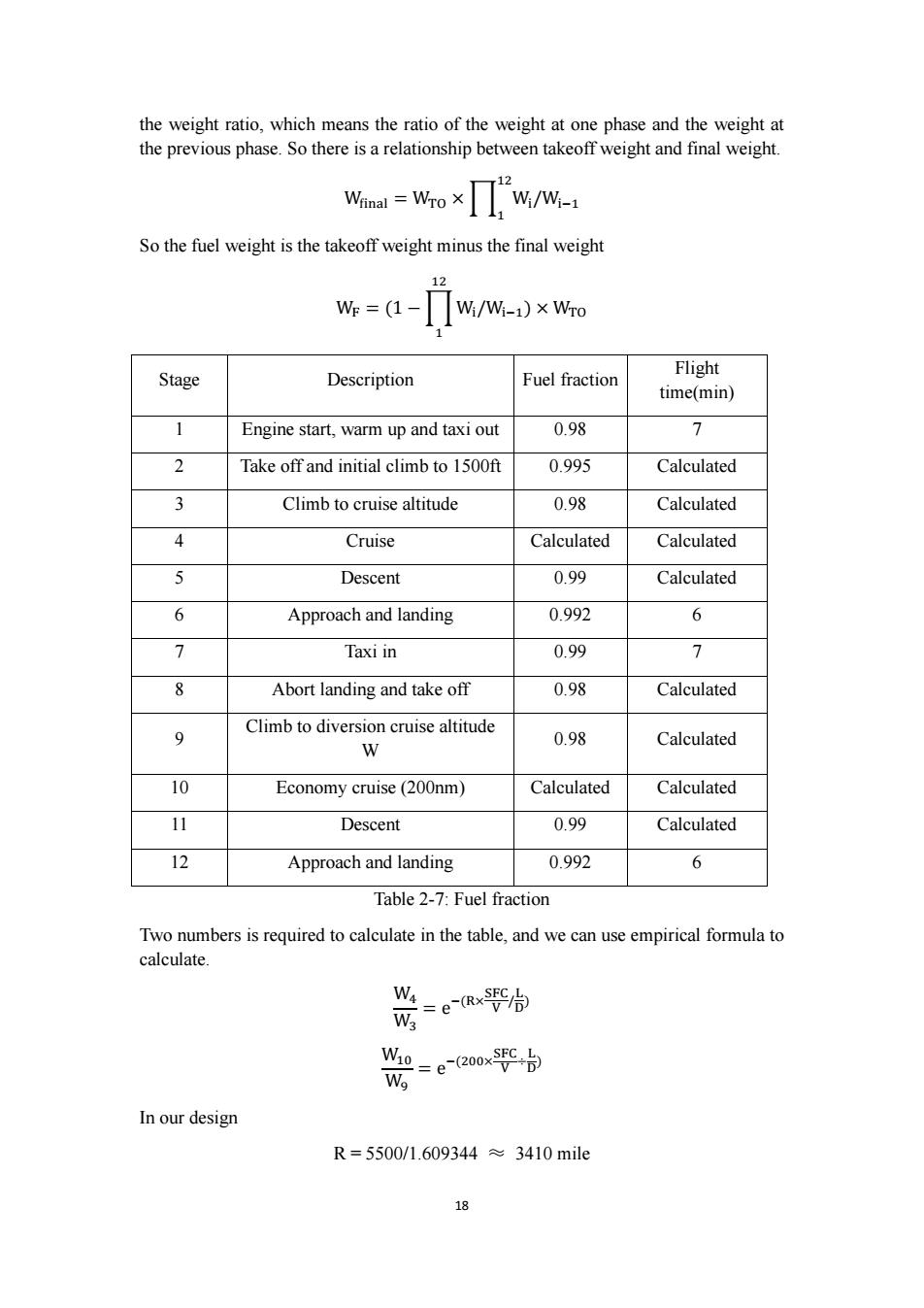
the weight ratio,which means the ratio of the weight at one phase and the weight at the previous phase.So there is a relationship between takeoff weight and final weight. 12 Waa=Wo×w/W-i So the fuel weight is the takeoff weight minus the final weight 12 W:=(1 W/w-1)×Wro Stage Fuel fraction Flight Description time(min) 1 Engine start,warm up and taxi out 0.98 1 2 Take off and initial climb to 1500ft 0.995 Calculated 3 Climb to cruise altitude 0.98 Calculated Cruise Calculated Calculated J Descent 0.99 Calculated 6 Approach and landing 0.992 6 Taxi in 0.99 7 8 Abort landing and take off 0.98 Calculated Climb to diversion cruise altitude 9 0.98 Calculated W 10 Economy cruise(200nm) Calculated Calculated 11 Descent 0.99 Calculated 12 Approach and landing 0.992 6 Table 2-7:Fuel fraction Two numbers is required to calculate in the table,and we can use empirical formula to calculate. =e-(RxSC) W4 W 0=e-(2ox-台 Wo In our design R=5500/1.609344≈3410mile 18
18 the weight ratio, which means the ratio of the weight at one phase and the weight at the previous phase. So there is a relationship between takeoff weight and final weight. So the fuel weight is the takeoff weight minus the final weight Stage Description Fuel fraction Flight time(min) 1 Engine start, warm up and taxi out 0.98 7 2 Take off and initial climb to 1500ft 0.995 Calculated 3 Climb to cruise altitude 0.98 Calculated 4 Cruise Calculated Calculated 5 Descent 0.99 Calculated 6 Approach and landing 0.992 6 7 Taxi in 0.99 7 8 Abort landing and take off 0.98 Calculated 9 Climb to diversion cruise altitude W 0.98 Calculated 10 Economy cruise (200nm) Calculated Calculated 11 Descent 0.99 Calculated 12 Approach and landing 0.992 6 Table 2-7: Fuel fraction Two numbers is required to calculate in the table, and we can use empirical formula to calculate. In our design R = 5500/1.609344 ≈ 3410 mile
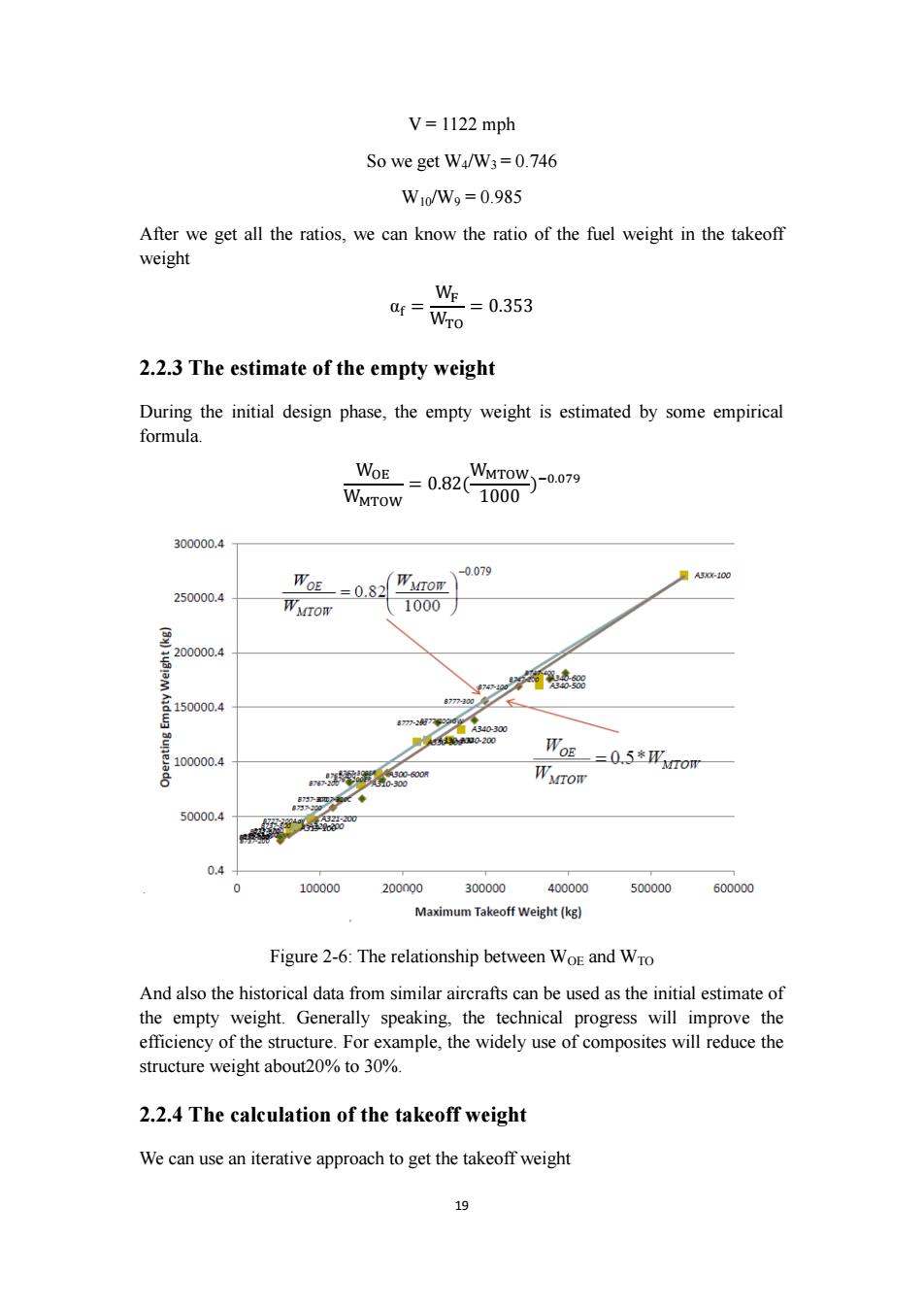
V=1122 mph So we get W4/W3=0.746 W1o/Wg=0.985 After we get all the ratios,we can know the ratio of the fuel weight in the takeoff weight WE 二WT0 =0.353 2.2.3 The estimate of the empty weight During the initial design phase,the empty weight is estimated by some empirical formula. WoE -=0.82 WMTOW -0.079 WMTOW 1000 300000.4 0.079 250000.4 W0E=0.82 WMTOW 75-100 WMIOW 1000 200004 三15000,.4 8777-900 77m-2799 A340-300 A.30200 100000.4 Wog=0.5*亚Mrom WMTOW 50000.4 0.4 100000 200000 300000 400000 500000 600000 Maximum Takeoff Weight(kg) Figure 2-6:The relationship between Woe and WTo And also the historical data from similar aircrafts can be used as the initial estimate of the empty weight.Generally speaking,the technical progress will improve the efficiency of the structure.For example,the widely use of composites will reduce the structure weight about20%to 30%. 2.2.4 The calculation of the takeoff weight We can use an iterative approach to get the takeoff weight 19
19 V = 1122 mph So we get W4/W3 = 0.746 W10/W9 = 0.985 After we get all the ratios, we can know the ratio of the fuel weight in the takeoff weight 2.2.3 The estimate of the empty weight During the initial design phase, the empty weight is estimated by some empirical formula. Figure 2-6: The relationship between WOE and WTO And also the historical data from similar aircrafts can be used as the initial estimate of the empty weight. Generally speaking, the technical progress will improve the efficiency of the structure. For example, the widely use of composites will reduce the structure weight about20% to 30%. 2.2.4 The calculation of the takeoff weight We can use an iterative approach to get the takeoff weight
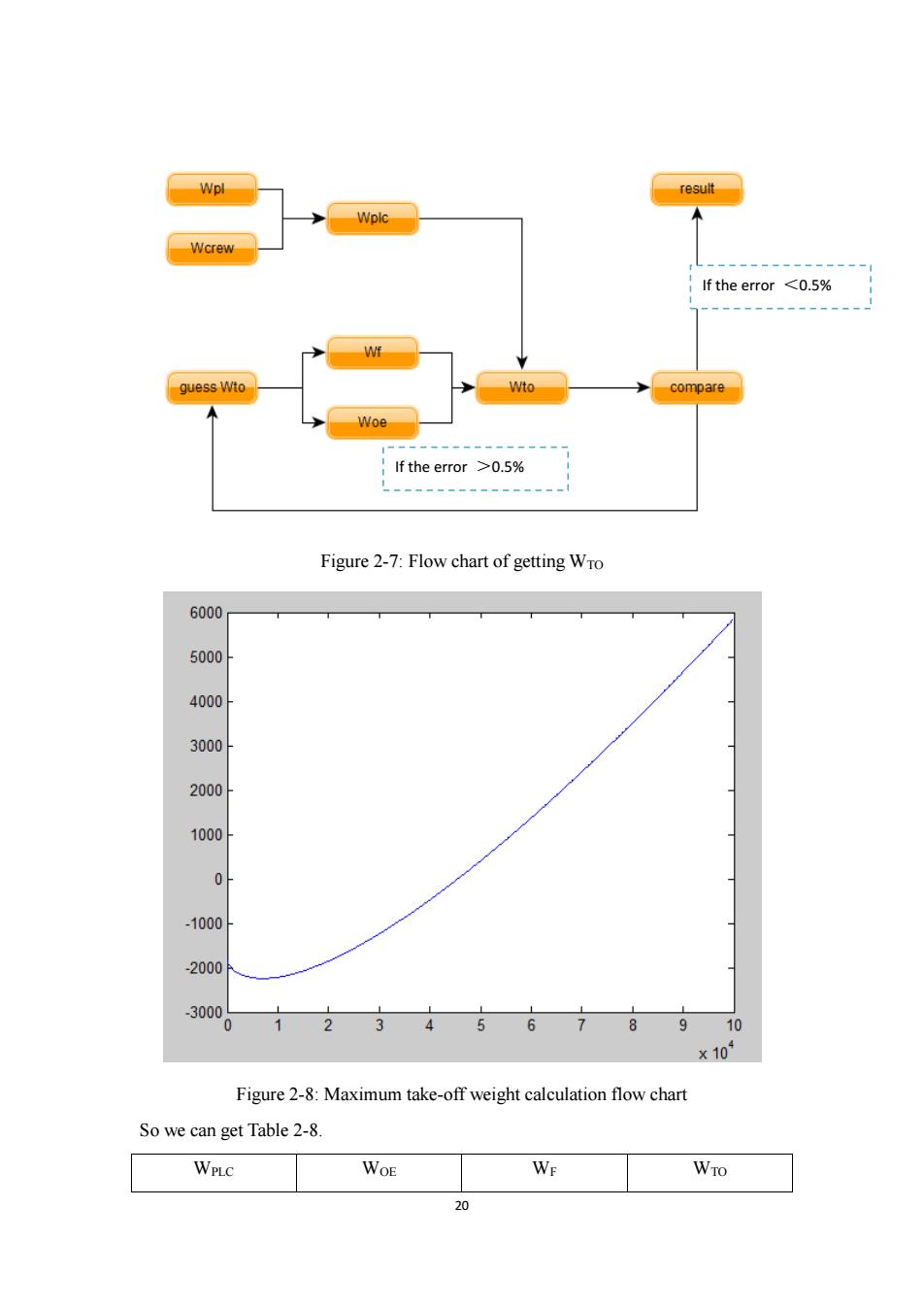
Wpl result Wplc Wcrew If the error <0.5% WE guess Wto Wto compare Woe If the error >0.5% Figure 2-7:Flow chart of getting Wro 6000 5000 4000 3000 2000 1000 0 -1000 -2000 3000 6 78 9 10 x104 Figure 2-8:Maximum take-off weight calculation flow chart So we can get Table 2-8. WPLC WoE WF WTo 20
20 Figure 2-7: Flow chart of getting WTO Figure 2-8: Maximum take-off weight calculation flow chart So we can get Table 2-8. WPLC WOE WF WTO If the error >0.5% If the error <0.5%